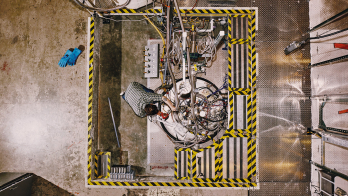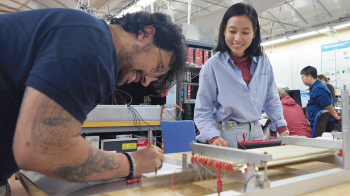As part of a series of articles about the new detectors for the Large Electron Positron (LEP) collider, the September 1984 issue of CERN Courier featured ALEPH. Located at point 4 of the LEP ring, in a cavern now filled with radio-frequency cavities for the LHC, ALEPH was a general-purpose detector that began data-taking in July 1989 and operated for 11 years until the end of LEP programme.
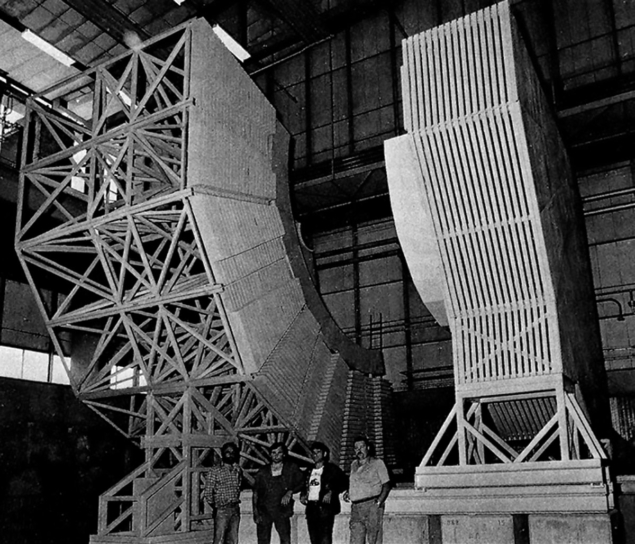
Our previous issue carried the first of a series of articles (DELPHI, page 27) on the four major experiments for CERN’s 9 kilometre diameter LEP electron–positron ring, now under construction and scheduled to produce its first colliding beams in 1988.
This month we continue with the ALEPH (Apparatus for LEP pHysics) detector. The typical electron–positron annihilations produced in LEP will be very complex, producing many particles, distributed in turn into showers (‘jets’) which may turn up anywhere in the spherical volume surrounding the beam crossing point. The ALEPH detector is designed to collect as much information about each event over as wide a spherical volume as possible.
It features a large superconducting coil enclosing a Time Projection Chamber as central track detector, designed to permit precise momentum determination of charged particles over a wide energy range, and a fine-grain calorimeter measuring electromagnetic energy deposition with very good spatial resolution.
ALEPH’s cost will work out at about 75 million Swiss francs at current prices, but will be ‘staged’, with a slightly cut-down version being ready to intercept the first beams, and final features being added later.
Like all the LEP experiments, ALEPH involves a lot of people – some 300 scientists from 25 research centres in nine countries and three continents. The line-up: Bari, Beijing, CERN, Clermont-Ferrand, Copenhagen, Demokritos Athens, Dortmund, Ecole Polytechnique, Edinburgh, Frascati, Glasgow, Heidelberg, Imperial College London, Lancaster, Marseille, Munich (Max Planck), Orsay, Pisa, Rutherford Appleton, Saclay, Sheffield, Siegen, Trieste, Westfield College London, and Wisconsin.
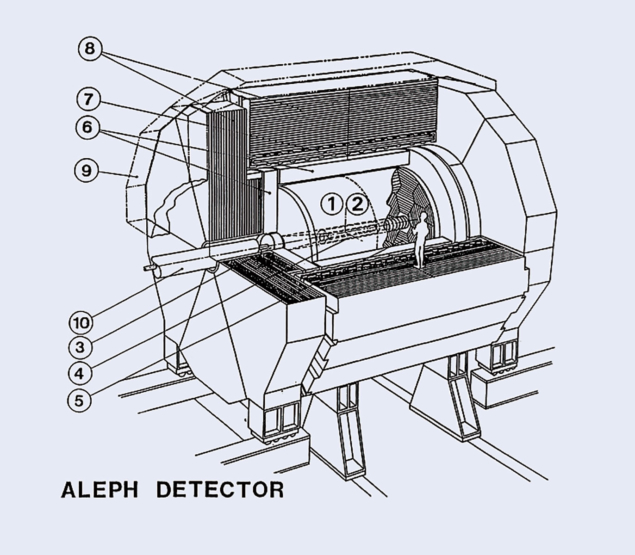
9 – muon detector, 10 – superconducting quadrupole.
The design is for concentric layers of detector, both inside and outside the main superconducting magnet coil, each fulfilling a separate function. The region is closed by multilayered endcaps, reflecting the configuration of the central detector.
The main solenoid, being built at Saclay, will provide a highly uniform magnetic field of 1.5 T in the central detector. The design owes much to the highly successful CELLO detector at the PETRA electron–positron ring at the German DESY Laboratory. It consists of a 6.4 m long, 5.3 m diameter main coil, with additional 40 cm compensators at either end. The superconducting cable is made of a copper-niobium-titanium composite, embedded in an aluminium band by an extrusion process.
With some 25 tons of equipment involved, cooldown from ambient temperature to the 4.2 K working point will take some two weeks. The rated current in the main coil will be 5000 A, giving some 130 MJ of stored energy. The coil and its cryostat will be built in two halves and transported to CERN by road. The iron supports have to be solidly built, as they have to withstand a magnetic force of 4000 tons pulling the two opposite end caps towards each other. The iron structure, refrigeration and necessary power supplies are being constructed at CERN.
The cylindrical central tracking detector inside the solenoid has to provide good momentum and angular resolution of particle tracks, while assuring good pattern recognition and distinguishing different types of particles by rate of energy loss. Thinking soon centred on a Time Projection Chamber (TPC), using an argon-methane mixture at atmospheric pressure and an applied drift field of about 20 kV/m in a volume of 42 m3.
Tracks of ionizing particles in the TPC will be measured by recurrent sampling of signals during the electrons’ drift time of some 35 microseconds before they arrive at the endplates, where they are recorded by a system of 3000 proportional wires and 22 000 cathode readout pads. The electrode configuration reflects experience gained with the TPC used at the PEP electron–positron ring at Stanford.
An ingenious laser calibration system will take care of field irregularities inside the TPC. Time Projection Digitizer (TPD) and Time Projection Processor (TPP) electronics will naturally take care of the huge amount of raw generated data, only a small proportion of which will actually correspond to useful track information.
A prototype (TPC 90, with endplates approximately the size of one of the 18 sectors for the final version) has been constructed and is now being put through its paces, using tracks produced by laser beams.
Development and construction work for the TPC is shared by CERN, Dortmund, Pisa, Munich, Trieste and Wisconsin, with Dortmund and Glasgow supplying the calibration system.
Inside the TPC will be the ALEPH Inner Chamber (Imperial College, London), a conventional cylindrical small cell drift chamber (outer radius 280 mm, inner radius 128 mm). This will provide additional tracking close to the beam pipe and its signals will provide an essential part of the primary electronics trigger.
Inside the Inner Chamber, a 105 mm outer radius minivertex detector (Pisa) will eventually be installed. Based on multi-electrode silicon detectors, it will provide the close tracking increasingly used these days to detect the short-lived particles which decay very close to the interaction point. Either side of the inner detectors and at the centre of the end-caps will be luminosity monitors (Copenhagen and Siegen).
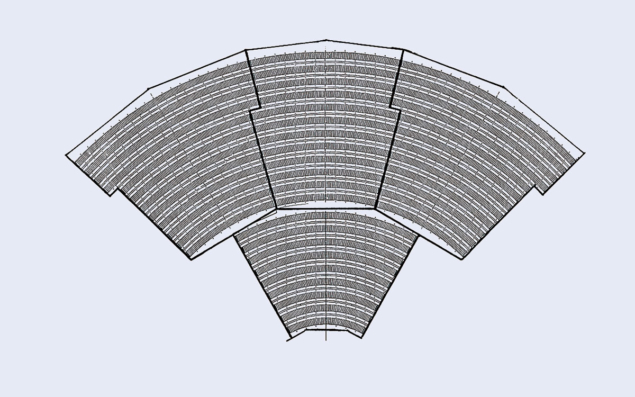
Inside the solenoid but outside the TPC will be the electromagnetic calorimeter, based on a 2 mm lead plus wire chamber sandwich design providing good transverse granularity, matched to the size of the produced electromagnetic showers, and organized into ‘ microtowers’, each with three longitudinal sections. The central barrel, made up of 12 11-ton modules, will contain 48 000 microtowers, while a further 24 000 will be in the end-caps, giving a total of 216 000 electronics channels.
The electromagnetic calorimeter end-caps are supplied by the Rutherford Appleton Laboratory and Glasgow, while the barrel involves a French (Clermond-Ferrand/Ecole Polytechnique/Marseille/Orsay/Saclay) collaboration.
Outside the solenoid, the 120 cm of iron which supports the rest of the detector and provides the magnet return yoke will be packed with instrumentation (1 cm2 plastic streamer tubes) to measure the deposition of hadronic energy and to pick up the muons which penetrate the rest of the apparatus. The instrumentation comprises a total of 56 000 streamer tubes and a further 82 000 tubes in the 9 m diameter end-caps. The readout is organized into projective towers. The hadron calorimeter is an Italian effort, with Frascati providing the barrel, and with Pisa and Bari supplying the end-caps.
The muon detector uses double layers of streamer tubes to pick up the muons traversing the iron of the hadron calorimeter. The outer layer will probably only come into operation after the initial electron–positron collisions have been studied.
As with all experiments using high luminosity colliding beams, great emphasis is placed on ALEPH’s data acquisition and handling system. A fast first level trigger, using information from the inner chamber, the hadron calorimeter, the electromagnetic calorimeter, the muon chambers and the luminosity monitor, will act within a few microseconds, priming the TPC electronics and initializing the second level trigger. Since beam crossing occurs only every 23 microseconds, this will not lose precious information.
The second level trigger will mainly use information from the TPC to ensure that tracks point back towards the beam crossing point. This will reduce the trigger rate to something less than 10 Hz.
The final trigger will reduce the data collection rate down to a level (a few events per second) suitable for writing to magnetic tape for subsequent off-line processing. The development of the triggering system is supervised by Heidelberg and Rutherford. Fastbus electronics will be prominent throughout.
There is no recipe for building a detector for discovering the unknown, especially when the unknown is likely to involve rare and complex particle interactions. However the ALEPH team believes that its detector will be able to disintangle much of this complexity, providing an optimal instrument both for studying the known and discovering the unknown.
- This article was adapted from text in CERN Courier vol. 24, September 1984, pp269–272







